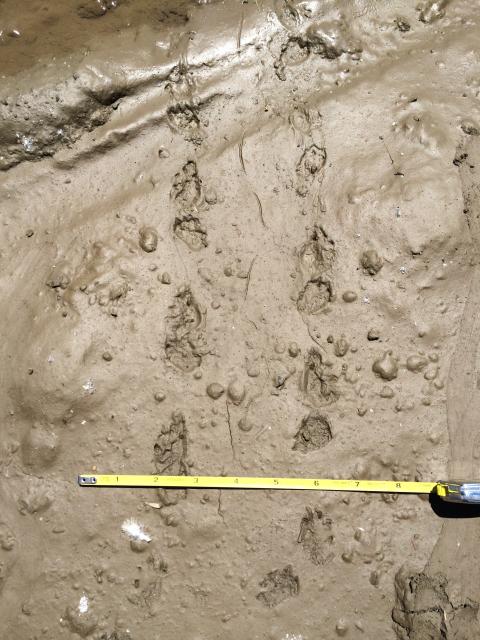Using Wildlife Track and Sign to Identify Nongame Species
Learning to identify wildlife track and sign can be a great tool for any landowner or community wanting to know more about what wildlife species are using their property. I find people tend to associate wildlife track and sign with our game species – deer tracks and antler rubs, moose tracks and browse, bear tracks and scat, etc. – and people are often surprised to learn you can identify the presence of nongame species with track and sign identification as well.
Below you’ll find some examples of tracks and sign left behind by some of our nongame or lesser-tracked species, and tips on how to identify them. You can also join Taking Action for Wildlife team members Haley Andreozzi, and Emma Tutein for a winter wildlife tracking workshop this winter to learn more!
In the right conditions, reptiles (turtles and snakes) and amphibians (frogs, toads, and salamanders) can leave behind tracks and sign. Here are a couple of examples:

A turtle’s trail appear as two parallel lines of tracks or foot prints. The width of the trail can be an indication of species, but remember that all turtles start out small, so it can be challenging to determine what the turtle species might be based on trail width alone. You may also often see drag marks from the turtles tail between the foot prints, as seen in this photo towards the top of the trail.

Another indication that turtles may be present are predated turtle nests. Turtles dig holes to lay their eggs, and they are often dug up and eaten by predators, leaving behind the sign you see in this photo – a hole with many turtle egg shells left behind. The number of egg shells found can be an indication of species, as snapping turtles will lay significantly more eggs than our other, smaller turtle species.

These are likely the tracks of a toad walking across a sandy area. Frog and toad tracks can be very hard to tell apart. Some details can help narrow it down – toads TEND to walk and frogs TEND to hop – and habitat and context clues may also help.
Despite their small stature, squirrels, chipmunks, moles, voles, shrews, and mice all leave behind tracks and sign. Learning to distinguish the differences in tracks between some of these small critters can be tricky, but here are a couple examples of unique sign left behind by some of our smallest mammals.

This photo shows where meadow voles were feeding on the bark of a shrub underneath the snow, revealed after some snowmelt in late winter. Many of our small mammals remain active underneath in wintertime protected under the snow in what is called the subnivean layer. Meadow voles and other small rodents will feed on the bark of shrubs and young trees underneath the snow.

Red squirrels collect cones in the fall and store them together in one place to eat through the winter. Here you can see a collection of cones in the background and in the foreground, you can see cones that have been fed on. This strategy of storing food for winter all together in one place is called larder hoardering. The pile of cones and refuse from eating them is called a midden.
With somewhere between 10 and 20,000 insect species in NH alone, it’s no surprise that they leave their mark. It might require a close look, but you can likely find many signs left by insects in your neighborhood. Here are just a few examples:

Tent caterpillars lay their eggs in the fall encircling a twig. These eggs overwinter and hatch in the spring. With a careful eye, you can find egg masses in the wintertime. Here you can see the previous year’s egg mass (on the right) which has hatched out, and the current year’s egg mass (on the left).

This photo shows the sign left behind by snails feeding on the algae growing on the bark of this tree. Snails have a special mouth part called a radula, which they use to scrape their food, in this case, the algae, into their mouth. You can see in the pattern left behind how they scrape across an area before moving forward and repeating the pattern.

Galls are abnormal plant growths usually caused by insects but also by fungi, mites, nematodes, and bacteria. This gall was formed when a type of fly laid its egg in the plant, which causes the plant to grow in an abnormal way, in this case almost resembling a flower of leaves, that encases and protects the fly’s larva as it develops.



